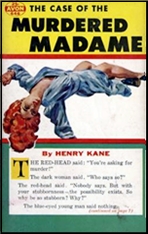Tue 11 Jul 2023
PI Stories I’m Reading: HENRY KANE “The Case of the Murdered Madameâ€.
Posted by Steve under Stories I'm Reading[2] Comments

HENRY KANE “The Case of the Murdered Madame.†PI Peter Chambers, Lead story in the collection of the same name: Avon #646, paperback original, 1955. Reprint edition: Signet D2646, paperback, May 1965.
Both Henry Kane, the author, and Peter Chambers, his most well-known private eye detective character, came onto the scene at the same time, in 1947, first with a handful of stories for Esquire magazine, then a hardcover novel, A Halo for Nobody, from Simon & Schuster. I haven’t followed Kane’s career well enough to state this as more than a working hypothesis, but based only on the scanty evidence I have so far, Peter Chambers’ early adventures seem to combine as well as anyone hard-boiled PI mystery fiction with the older-fashioned traditional detective novel, complete with clues, alibis, and the like.
Take “The Case of the Murdered Madame,†for example. While not a locked room mystery or an impossible crime in any sense, it is a case in which a murder takes place in a house where there are only a limited number of suspects, each with a common motive – that is to say, the theft of $100,000 in cash the dead woman has made abundantly known to the other tenants of the rooming house catering to theatrical folk living there.

Peter Chambers’ job: find out who did it.
The fact that it was a dark rainy night comes into play in twofold fashion, first in terms of limiting the number of suspects, then secondly in providing Chambers with the clue he needs to name the killer.
The story is too short to provide much in the way of characterization, but the sheer rhythm of Kane’s prose, almost unique in the annals of detective fiction, is a pure plus that adds considerably to the enjoyment of this short but snappy tale.
PostScript: The Avon paperback of the same title appears to have been the first appearance of this story. What caught me by surprise in reading the Signet reprint was that there is no contents page, and therefore no suggestion ahead of time that the book is a collection of three stories, the other two, also cases cracked by Peter Chambers, those two both first appearing in the pages of Manhunt magazine.
In any case, though, while reading the story, I was thinking it was a novel, and here Peter Chambers was, summing the case up against the killer, and I’m only a third of he way into the book. What’s going on, I thought. What kind of twist is this?
July 11th, 2023 at 8:19 pm
Those rhythms you speak of are one reason the cool hip Chambers was suspected to be the model for Peter Gunn.
Kane was capable of both the solid plot and hard-boiled tough guy stuff. It’s a shame Chambers went out on a low point with those not so soft-core Lancer paperbacks, but Kane himself made a comeback with Inspector MacGreggor and as Anthony McCall with critical and financial success, he even managed a post Chambers mainstream novel that sold pretty well.
July 12th, 2023 at 1:33 pm
The connection between Peter Chambers and Peter Gunn goes beyond the shared first name. When it came time to publish a novel based on the series, it as Henry Kane who got the call. And as I remember, he did a great job with it.